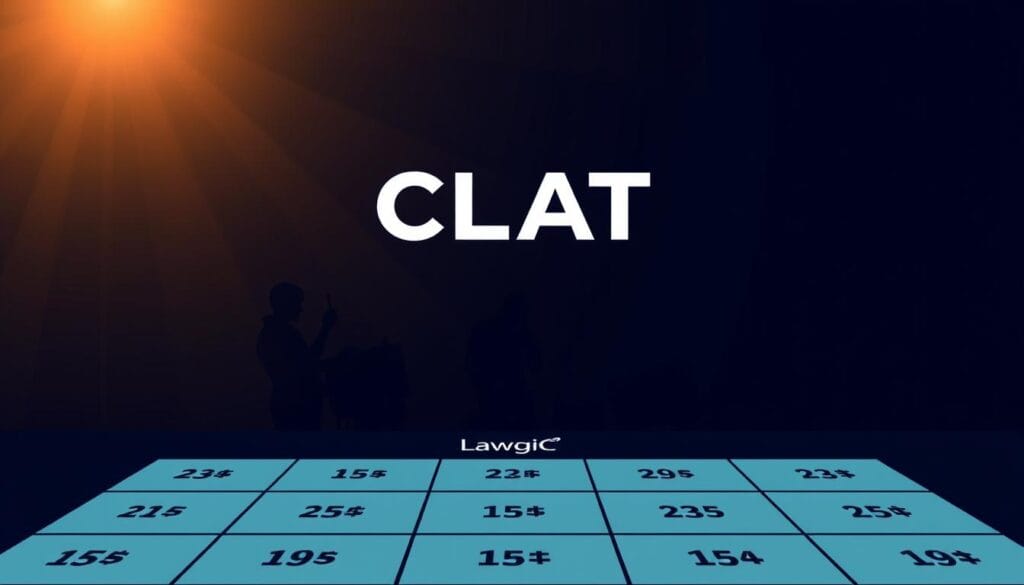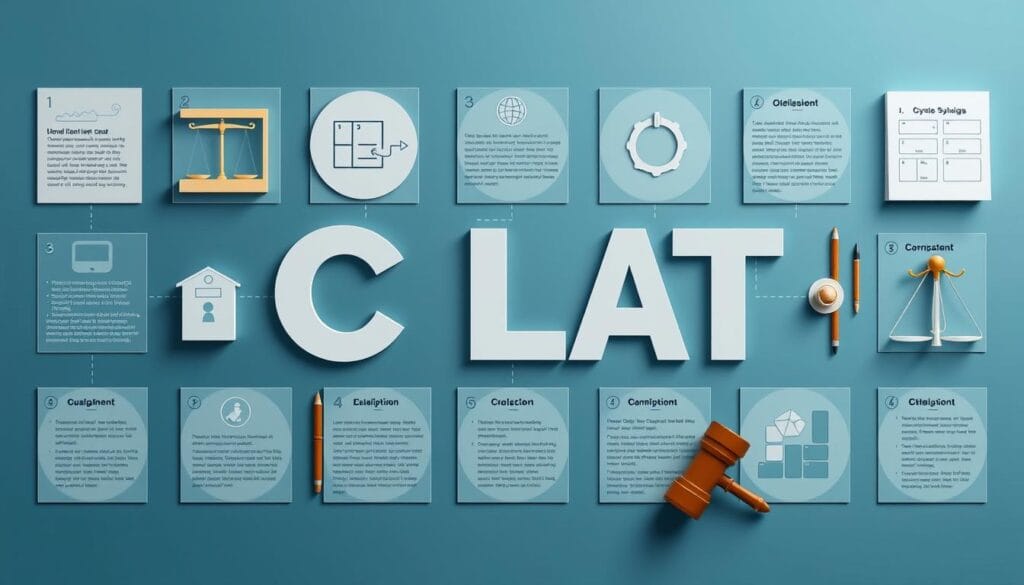Can one clear strategy make the coming test feel predictable and winnable?
You need a clear map, not more confusion. The UG‑CLAT 2026 exam pattern and syllabus outline a two‑hour, pen‑and‑paper test with 120 multiple‑choice questions across five sections. Most items come from ~450‑word passages that test comprehension, inference, and applied reasoning.
You’ll learn how the five-section blueprint—English, Current Affairs, Legal Reasoning, Logical Reasoning, and Quantitative Techniques—shapes your reading plan and daily practice. We show which question trends return the highest marks and how to respect negative marking while staying aggressive with attempts. For more effective strategies, consider exploring additional CLAT preparation tips.
Use past papers as a skill engine. With focused practice, you build speed reading, accurate inference, and argument analysis. This intro points you to the right priorities and to targeted prep resources for guided mocks and mentorship.
Key Takeaways
- Past papers reveal which topics actually matter and which fade over the years.
- Focus on passage-led skills: reading speed, inference, and reasoning.
- Align daily practice with section-wise question distribution to boost score potential.
- Respect negative marking: learn when to guess and when to skip.
- Use curated mocks and 1:1 strategy to make progress measurable and steady.
Why Aligning the CLAT Exam Pattern and Syllabus with Previous Year Papers Boosts Your Score and Rank
Pairing focused study with real past questions gives you a sharper, evidence-backed plan.
You must treat practice tests as a map, not just practice. The official format uses ~450-word passages and a fixed 120-minute window for 120 questions, so your weekly plan should mirror that stress.
Prioritize by weightage. Current affairs and legal reasoning carry the most items (about 28–32 each). That means you should allocate more timed drills and targeted reading to those topics.
Past papers reveal how reasoning and comprehension drive scores in passage formats. They show repeat question types, common traps, and where simple knowledge gaps cost marks. To further enhance your preparation, consider utilizing resources like the CLAT mock test series, which can provide you with valuable practice and insights into your performance.
- Use PYQs to map effort to returns: spend more time on high-weightage areas.
- Time your practice to learn how long a set really takes, then reallocate minutes to easier wins.
- Turn insights into action: daily skill drills, timed mocks, and weekly reviews.
CLAT Exam Pattern & Syllabus: the non‑negotiables you must know before you start
A clear view of timing, sections, and scoring helps you build a targeted plan.
Exam snapshot: you face 120 questions in 120 minutes on a pen-and-paper test. Each correct answer is +1 and a wrong one costs 0.25 marks, so accuracy matters as much as speed.
The paper has five sections: English Language; Current Affairs including general knowledge; Legal Reasoning; Logical Reasoning; and Quantitative Techniques.
How the format shapes your prep
Most questions come from ~450-word passages, so improving reading speed and inference is essential. Quantitative Techniques uses set-based data rather than long passages.
“Work on rhythm: one minute per question on average, with extra seconds for reading long passages.”
| Feature | Value | Notes |
|---|---|---|
| Total questions | 120 | +1 / -0.25 marking |
| Duration | 120 minutes | ~1 minute per question |
| Passage length | ~450 words | Applies to four sections; quantitative uses sets |
| Approx. distribution | English 22–26; Current Affairs 28–32; Legal Reasoning 28–32; Logical Reasoning 22–26; Quantitative 10–14 | Allocate practice time by weight |
Expect consistency with the exam pattern 2025 format. Plan practice that mirrors this distribution and time pressure.
Syllabus vs. Previous Year Papers: how to prioritize topics, weightage, and question trends
Use weightage from previous years to convert broad topics into a weekly, high-yield practice map.
Start with distribution, not guesswork. Past papers show that passage-led sets dominate English, Current Affairs, legal reasoning, and logical reasoning, while quantitative techniques use data sets. For those looking to enhance their preparation, consider personalized mentorship to tailor your study approach effectively. Prioritize Legal Reasoning and Current Affairs (about 28–32 questions each) for more timed drills.
Track recurring topics—constitutional basics, international affairs, economy reports, and ethics—to build a compact topics list. Let PYQs tell you which themes are evergreen and which spike only one year.
“Comprehension accuracy drives both legal and logical reasoning outcomes.”
Convert trends into weekly drills: timed passage practice for reading and inference, targeted sets for reasoning, and short note pages for high-yield law facts. Review time-per-question from past papers so you know where to skim and where to slow down.
- Checklist: weightage-led focus, PYQ topic logs, weekly timed drills, monthly trend review.
Section‑wise focus areas that consistently convert to marks
Targeted drills per section turn broad topics into reliable marks on test day.
English (comprehension): practice extracting the main idea, spotting tone, and choosing precise vocabulary in context. Summarize ~450-word passages and answer linked questions under a strict time cap to build pace.
Current Affairs including general knowledge: run a weekly cycle for constitution basics, international affairs, economy indicators, and key reports. Keep short monthly notes and revise high-frequency facts.
Legal reasoning: focus on locating rules inside passages and applying them to new facts. You don’t need prior law study—train on public-policy scenarios and principle application.
Logical reasoning: drill argument structure, assumptions, strengthen/weaken items, and parallel reasoning. Use elimination and back-solving to speed through common formats.
Quantitative techniques: build a quick-calculation toolkit for data interpretation, ratios, percentages, averages, and mensuration basics. Time short sets until you hit consistent accuracy.
“Use past questions to validate mastery—track accuracy and time per question to convert practice into score.”
- Rotate sections weekly so high-weight areas get more slots.
- Use calibrated mocks and sectional drills at lawgiccoaching resources if you need adjustments.
Reading and time strategy for a passage‑heavy test
When the paper leans on long passages, your reading rhythm decides how many marks you can safely chase.
Skim first, then lock in. On your first pass, capture the scope, stance, and main idea. Mark contrast words, dates, and named principles so you return faster to the facts that matter.
Skimming, annotating, and eliminating traps under time pressure
Annotate brief cues—one- or two-word tags in the margin. That saves seconds when questions point to the same line or claim. For further strategies on enhancing your exam preparation, you can visit this resource.
Use elimination confidently. Cross out choices with extreme language or statements that add facts the passage never stated. For additional tips, check out this link.
“Two quick reads beat one slow read: first for structure, second for tricky inferences.”
Time distribution by section based on question range and difficulty
Allocate minutes by weight and by your accuracy history. Give more buffer to legal reasoning and current affairs if those sections yield marks for you.
| Section | Approx. questions | Target time (minutes) |
|---|---|---|
| English (comprehension) | 22–26 | 24–28 |
| Current Affairs / GK | 28–32 | 28–32 |
| Legal reasoning / Logical reasoning | 50–58 | 40–44 |
| Quantitative techniques | 10–14 | 10–12 |
Accuracy vs. attempt: managing 0.25 marks smartly
With 120 questions in 120 minutes and a -0.25 marking penalty, you must protect accuracy while keeping attempts steady.
Use a two-pass plan: answer sure-shot items on pass one, flag medium items for pass two, and only guess when elimination gives you >50% confidence.
- Track seconds per question in mocks and tune your reading speed.
- In data-heavy quantitative techniques, pick familiar sets first to preserve rhythm.
- Label answers by confidence to learn when your instincts fail and refine elimination habits.
Practice tip: Use Lawgic’s mock series for realistic timing practice and the daily drill frameworks at Lawgic for pacing audits and reading skills.
Turning previous year papers into a weekly scoring engine
Make past papers work for you, not the other way around.
Make previous year questions the engine that drives your weekly study and measurable improvement. Start small: one timed section mid-week and a full mock on the weekend. Log time, accuracy, and the exact question type you miss.

How to analyze PYQs: weightage shifts, recurring passage themes, and reasoning patterns
Track weightage across years to spot shifts between constitutional, international, or economy topics. Tag recurring themes—data privacy, climate policy, federalism—so your reading is focused.
Break down misses by pattern: assumption errors, scope shifts, causal traps, or misapplied principles. For logical reasoning and legal reasoning, convert each error into a one-line rule and drill it until you cut repeat mistakes. Additionally, stay updated with the latest legal developments through resources like the Press Information Bureau, which can provide insights into current events and policy changes that may reflect in PYQs.
Mock test cadence and review loops to lift percentile faster
Run a mock cadence that compounds: one mini full-length mid-week, one full mock on weekend. This approach aligns with the CLAT exam pattern and syllabus, ensuring you are well-prepared for the test’s structure. Review every mock within 24 hours. Use a personal scoreboard to track net marks lost to negatives, minutes overshot, and section accuracy.
| Weekly Task | Frequency | Goal |
|---|---|---|
| Timed sectional practice | 2 sessions | Build speed on high-weightage topics |
| Full-length mock | 1–2 per week | Simulate test day rhythm |
| PQY analysis & notes | Ongoing | Convert mistakes into rules and short material |
“Practice, log, review, adapt — repeat weekly to see steady percentile gains.”
Download, schedule, and simulate at https://lawgiccoaching.com/clat-mock-test-series for realistic material and try the personalized plan at https://lawgiccoaching.com/personalized-mentorship to keep your preparation accountable.
Trusted resources and links for pattern clarity, updates, and practice
Authoritative websites keep your plan aligned with the latest notifications and section distribution.
Official notifications and pattern updates
For authoritative information, check the Consortium of NLUs site for final notices and any change to the exam pattern 2025. Bookmark the page and review instructions before your admit card is issued.
- Consortium of NLUs: https://consortiumofnlus.ac.in
- Collegedunia (quick distribution guide): https://collegedunia.com/exams/clat/exam-pattern
- NTA for national testing practices: https://nta.ac.in
Daily current affairs you can rely on
Build a 30–45 minute daily routine around PIB releases and one deep editorial read. That anchors your knowledge current affairs and general knowledge without overload.
- Press Information Bureau: https://pib.gov.in
- The Hindu (Education): https://www.thehindu.com/education/
- Indian Express Education: https://indianexpress.com/section/education/
- Hindustan Times Education: https://www.hindustantimes.com/education
High‑impact internal prep tools
Use focused material to convert official information into skills. Schedule two mocks weekly and run structured reviews with a checklist.
- Strategy tips and daily drills: https://lawgiccoaching.com/clat-preparation-tips
- Mock series for timed practice: https://lawgiccoaching.com/clat-mock-test-series
- Personalized mentorship and success stories: https://lawgiccoaching.com/personalized-mentorship, https://lawgiccoaching.com/student-success-stories
- Contact for help: https://lawgiccoaching.com/contact
“Combine official notices with curated practice to stay accurate and efficient in your prep.”
Common CLAT prep mistakes that cost marks (and fixes)
A few repeated errors in your routine usually explain most score plateaus.
Over-attempting despite negative marking eats into your net score because wrong answers cost 0.25 marks. Set a confident-answer threshold and flag uncertain items for a second pass.
Rushing through long passages wastes time and causes misreads. Annotate contrast words, claims, and principles so you return quickly and avoid re-reading.
Studying topics randomly dilutes results. Follow section weightage and PYQ trends so your preparation and practice align with scoring opportunities.

Ignoring error patterns turns small slips into repeated losses. Keep a review log that labels each miss (trap option, scope shift, misread, calc error) and drill by label, not just topic.
Weak time management and rigid pacing harms answers on heavy reasoning sets. Allocate flexible time windows per section and reserve buffer minutes for tough legal or logical questions.
Neglecting fundamentals in quantitative techniques and current affairs wastes easy marks. Do daily 20-minute arithmetic sprints and link news to institutions for better application and understanding.
“Convert every mock into a learning cycle: re-solve errors within 24 hours and write one rule per mistake.”
Fix these faster with targeted mocks at lawgiccoaching, practical routines at lawgiccoaching, and a coach’s eye via personalized mentorship. For plan help, reach out at contact.
Conclusion
Close every week with a mock, a quick error map, and one clear action for next week.
This loop turns practice into progress. The current blueprint—120 questions in 120 minutes, +1/−0.25 marking, five sections, ~450-word passages in four sections and data sets in quantitative techniques—rewards steady, review-driven work.
Focus on comprehension, inference, and argument analysis while keeping short QT drills. Let section weightage guide your schedule and protect your score with disciplined risk rules.
Keep a living notes file, run a strict mock-and-review cadence, and use Lawgic’s resources for realistic practice: actionable strategies, exam-real mocks, and tailored mentorship at the links below. For additional insights and resources, check out the educational content available at The Hindu Education.
Start your next week with one change and measure it. Plan, practice, review, adjust—repeat.
Actionable strategies · exam-real mocks · personalized mentorship · Talk to us


